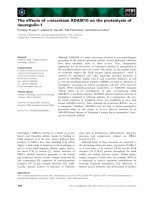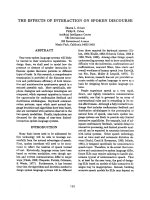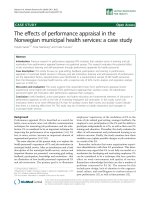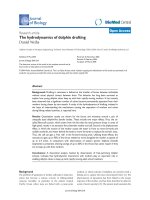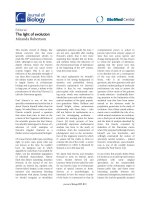Báo cáo sinh học: "The effects of lipids on channel function" pdf
Bạn đang xem bản rút gọn của tài liệu. Xem và tải ngay bản đầy đủ của tài liệu tại đây (487.99 KB, 3 trang )
Lee: Journal of Biology 2009, 8:86
Abstract
Anionic lipids affect the function of many channels, including
connexins, as shown in a recent report in BMC Biology. These
effects might follow from direct binding of the anionic lipids to
the channels.
Lipids affect channel function
Many membrane channels, for proper function, require the
presence of particular species of lipid in the surrounding
membrane. In a recent paper in BMC Biology, Locke and
Harris [1] provide an example of this: they showed that
connexin channels are inactive in a membrane composed
of just the zwitterionic lipid phosphatidylcholine (PC) but
become active in the presence of the anionic lipid phos-
phatidylserine (PS) (for lipid structures see Figure 1). The
full effect of PS is seen only when 60% or more of the lipid
is PS. The effect is not structurally specific; other anionic
lipids such as phosphatidic acid (PA) and phosphatidyl-
inositol (PI) have the same effect as PS. Similar observations
have been made with other channels. For example, the
probability that the potassium channel KcsA is open is very
low in bilayers of PC alone but increases with increasing
anionic lipid content [2]; the functions of inward rectifying
potassium channels are modulated by PIs [3]; and the
presence of anionic lipid increases the rate of flux of small
molecules through the mechanosensitive channel MscL [4].
Lipid binding to channels
How are the effects of anionic lipid on channel function to
be understood? In some cases the interaction of lipid with
a membrane protein is highly specific. For example, a
single molecule of the anionic lipid phosphatidylglycerol is
seen in the X-ray crystal structure of the heterotrimeric
nitrate reductase A, bound in a distinct pocket formed by
all three subunits, with three positively charged residues
contributing to the binding site [5]. In this case binding is
strong as well as structurally specific, because the lipid
remains bound during the process of crystallization from
detergent solution. However, most lipid molecules inter-
acting with a membrane protein are not buried within the
structure in this way, but are located on the transmembrane
surface of the protein, forming a ring or annulus around
the protein [6]. These annular lipid molecules ‘solvate’ the
transmembrane surface of a membrane protein in the
same way that water molecules solvate the surface of a
water-soluble protein. Given that the effects of anionic
lipid on channel function are generally seen only at high
concentrations of the anionic lipid, it is likely that the
Minireview
The effects of lipids on channel function
Anthony G Lee
Address: School of Biological Sciences, University of Southampton, Southampton, SO16 7PX, UK. Email:
Figure 1
Lipid structures and phases. (a) The structure of the major
glycerophospholipids phosphatidic acid (PA), phosphatidylcholine
(PC), phosphatidylethanolamine (PE), phosphatidylserine (PS) and
phosphatidylinositol (PI), which differ only in the group indicated by
X. Yellow indicates the hydrophobic tail; orange indicates the
charged headgroup, which can be anionic or, where there is a
positive and a negative charge, zwitterionic. (b) Lipids with a
cylindrical shape, such as PC, pack as bilayers. (c) Lipids with a
conical shape, such as PA or PE, pack in curved structures such as
the hexagonal H
II
phase.
Cylinder
Bilayer
Cone
Hexagonal phase
P
O
-
O
O
X
O
H
O
O
O
O
N
+
PC
NH
3
+
PE
NH
3
+
O
O
-
H
PS
HO
OH
OH
OH
OH
1
2
3
4
5
6
PI
X = H
PA
(a)
(b)
(c)
86.2
Lee: Journal of Biology 2009, 8:86
relevant lipid-protein interactions are relatively weak, and
that the observed effects are caused by anionic lipids
binding at annular sites on the channel.
Although annular lipid molecules are seldom seen in X-ray
crystal structures, they are seen in a few special cases, such
as in the crystalline arrays formed by aquaporins (Figure 2a)
[7]. The annular lipid molecules are seen to be highly
distorted to match the rough surface of the protein. Inter-
actions of the lipid headgroups with the protein involve a
set of weak charge and hydrogen bonded interactions, as
shown in the molecular dynamics simulation in Figure 2b [8].
Binding of lipid molecules at annular sites is described by a
set of exchange reactions at each site. For example, an
annular site on a membrane protein located in a bilayer
containing a mixture of PC and PS could be occupied by
either a PC or by a PS molecule:
Protein-PC + PS Protein-PS + PC
This exchange reaction is defined by an equilibrium
constant K, the relative lipid binding constant for PS
compared with PC:
K = [Protein-PS][PC]/[Protein-PC][PS]
Slightly stronger binding of PS than PC at a particular site
(K > 1) will ensure that the site is occupied mostly by PS at
the relatively high concentrations of anionic lipid required
to affect channel function. For example, in a bilayer
contain ing 60% PS, an annular site will be 90% occupied
by PS if binding of PS at the site is just five times stronger
than binding of PC. This binding would affect channel
function if it resulted in a significant conformational
change in the channel.
A functionally important annular lipid binding with a
preference for anionic lipids has been demonstrated on
MscL, for which the ‘hot spot’ for binding anionic lipid was
shown to correspond to a cluster of three positively charged
residues [4]; it is likely that similar clusters of positively
charged residues close to the lipid-water interface occur on
other membrane proteins. In their recent paper, Locke and
Harris [1] report a mass spectrometric method for detect-
ing specificity in lipid binding to connexin channels. They
expressed connexin26 and connexin32 in HeLa cells,
isolated hemichannels (that is, channels that had not yet
formed gap junctions linking apposed cells) using a non-
ionic detergent, and characterized the lipids remaining
with the hemichannel preparation; lipids associated with a
gap junction preparation were also analyzed. Although all
classes of lipid were found associated with the hemi channels,
there was an enrichment in anionic lipids, consistent with
interaction with clusters of positively charged residues of
the type suggested above. Indeed, the crystal structure of
connexin26 shows a concentration of positively charged
residues at the lipid-water interface, on the intracellular
side [9].
Locke and Harris [1] also found that lipids with particular
combinations of fatty acyl chains remained with the
purified connexin26 samples, whereas lipids with other
combi nations of fatty acyl chains remained with the
purified connexin32 samples. It would be surprising if this
reflected chain-specific binding to the connexins because
the effects of chain structure on lipid binding to membrane
proteins are generally small [6]. Another possibility, as
described by Locke and Harris [1], is that the fatty acyl
chain compositions of the cells expressing connexin26 and
connexion32 are slightly different.
Collective physical properties
Because high concentrations of anionic lipid are needed to
affect channel function, there is another possible
mechanism for the effects of anionic lipid that needs to be
considered. Large changes in the chemical composition of
a bilayer will result in changes in collective physical
properties of the bilayer, such as its thickness and fluidity,
and in the related properties of spontaneous curvature and
pressure profile across the membrane [6]; it is therefore
conceivable that any observed changes in channel function
follow from changes in these collective physical properties
rather than from changes in the pattern of charge and
hydrogen-bonding interactions between the lipids and the
proteins described above.
Figure 2
Annular lipids. (a) Part of the transmembrane surface of aquaporin,
showing bound annular lipid molecules. The protein is shown as a
surface plot colored by charge (blue, positive; red, negative), with the
lipid molecules shown in space-filling format (red, oxygen; orange,
phosphorus; grey, carbon). From Protein DataBank (PDB) code 2B6O.
(b) A snapshot from a molecular dynamics simulation of a
transmembrane α-helix in a lipid bilayer. The helix is the sixth
transmembrane α-helix of the potassium channel Kv. The lysine side
chain can be seen hydrogen bonding to phosphate and ester oxygens
of a phosphatidylcholine (PC) molecule, and the tryptophan side chain
forms a hydrogen bond to an ester oxygen. Modified from [8].
Lys
Trp
PC
PC
Lys
Trp
PC
PC
(a) (b)
86.3
Lee: Journal of Biology 2009, 8:86
Recently, interest has focused on the spontaneous curva-
ture of the membrane. Spontaneous curvature relates to
the idea that lipids have a distinct ‘shape’ (Figure 1). A lipid
such as PC, in which the lipid headgroup and the two fatty
acyl chains occupy roughly equal areas in the plane of the
lipid bilayer, has a cylindrical shape, and so packs well into
a bilayer (Figure 1b). However, a lipid such as PA or phos-
pha tidylethanolamine (PE), for which the area of the
headgroup is small relative to that of the two chains, has a
conical shape and will prefer to pack into a curved struc-
ture such as the hexagonal H
II
phase (Figure 1c); these
lipids have a spontaneous curvature, whereas PC does not.
One way in which it has been proposed that this could have
a significant effect on protein function is illustrated in
Figure 3. If the thickness of the transmembrane region of a
channel were to increase on channel opening, the bilayer
would have to stretch around the open channel to prevent
exposure of hydrophobic groups to water. This stretching,
because it involves a curving of the membrane in the
vicinity of the protein, would be favored by a lipid such as
PA or PE that favors a curved structure. The explanation
requires, of course, that there should be a significant
change in hydrophobic thickness for the channel on open-
ing and there is, as yet, no evidence that this is the case.
Nevertheless, mem brane protein function has often been
observed to be differ ent in PE and in PC, a difference that
could be attributed to the different spontaneous curvatures
of PE and PC. How ever, studies of the effects of lipids with
headgroups inter mediate between those of PE and PC, with
one and two methyl groups, suggest that what is important
is not sponta neous curvature but the ability to hydrogen
bond [4,10].
What conclusions can be drawn from these studies? It is
clear that the presence of anionic lipids, generally at high
concentrations, affects the function of a wide range of
channels. In MscL the anionic lipids bind to a cluster of
positively charged residues close to the lipid-water
interface, and similar charge interactions are likely to be
important for other channels. It is also likely that the
effects of anionic lipids on channel function follow directly
from binding to these charge clusters, although the
possible importance of the collective physical properties of
the lipid bilayer cannot yet be ruled out.
References
1. Locke D, Harris AL: Connexin channels and phospholipids:
association and modulation. BMC Biol 2009, 7:52.
2. Marius P, Zagnoni M, Sandison ME, East JM, Morgan H, Lee
AG: Binding of anionic lipids to at least three nonannular
sites on the potassium channel KcsA is required for
channel opening. Biophys J 2008, 94:1689-1698.
3. Fan Z, Makielski JC: Anionic phospholipids activate ATP-
sensitive potassium channels. J Biol Chem 1997, 272:5388-
5395.
4. Powl AM, East JM, Lee AG: Importance of direct interactions
with lipids for the function of the mechanosensitive
channel MscL. Biochemistry 2008, 47:12175-12184.
5. Bertero MG, Rothery RA, Palak M, Hou C, Lim D, Blasco F,
Weiner JH, Strynadka NCJ: Insights into the respiratory
electron transfer pathway from the structure of nitrate
reductase A. Nat Struct Biol 2003, 10:681-687.
6. Lee AG: How lipids affect the activities of integral mem-
brane proteins. Biochim Biophys Acta 2004, 1666:62-87.
7. Gonen T, Cheng YF, Sliz P, Hiroaki Y, Fujiyoshi Y, Harrison SC,
Walz T: Lipid-protein interactions in double-layered two-
dimensional AQPO crystals. Nature 2005, 438:633-638.
8. Shrivastava IH, Capener CE, Forrest LR, Sansom MSP:
Structure and dynamics of K
+
channel pore-lining helices:
a comparative simulation study. Biophys J 2000, 78:79-92.
9. Maeda S, Nakagawa S, Suga M, Yamashita E, Oshima A,
Fujiyoshi Y, Tsukihara T: Structure of the connexin 26 gap
function channel at 3.5 Å resolution. Nature 2009, 458:597-
602.
10. Hakizimana P, Masureel M, Gbaguidi B, Ruysschaert JM,
Govaerts C: Interactions between phosphatidylethanolamine
headgroup and LmrP, a multidrug transporter. J Biol Chem
2008, 283:9369-9376.
Published: 6 October 2009
doi:10.1186/jbiol178
© 2009 BioMed Central Ltd
Figure 3
How spontaneous curvature of lipids could affect channel function. The
hydrophobic thickness of the lipid bilayer matches that of the channel
in the closed state, but the hydrophobic thickness of the channel could
increase on channel opening. This would require stretching of the lipid
bilayer around the protein to maintain hydrophobic matching, and the
associated curving of the bilayer would be easier if the lipid bilayer
contains lipids that prefer to adopt a curved structure.
Closed Open


